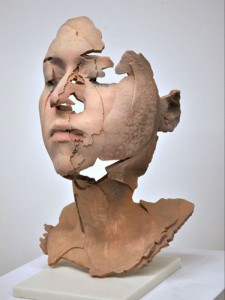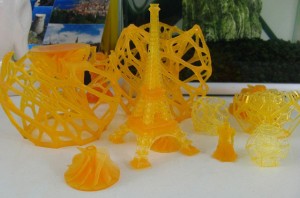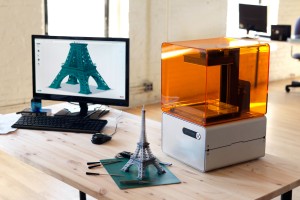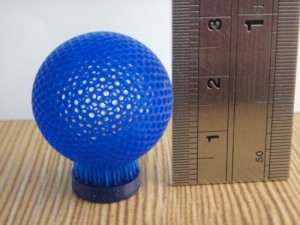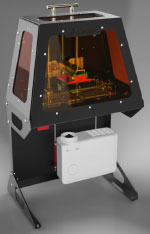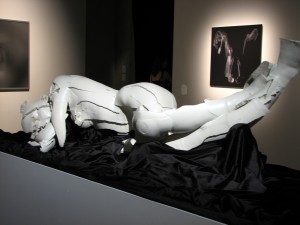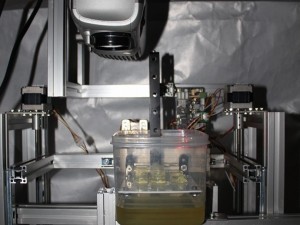DLP 3D PRINTER
One of the hottest new technologies in the DIY community is DLP 3D printers. DLP stands for Direct Light Processing. It is the process of using light to cure photopolymer resin into solid 3D objects one layer at a time. DLP printers are different from 3D printers like the Makerbot Replicator2 in that the Replicator heats plastic and prints it one layer at a time. This process is know as Fused Deposition Modeling or FDM. Most 3D printers melt down a filament similar to a weed whacker line into a puddle of molten plastic which is squeezed through a tiny hole to produce a tiny thread of plastic. The thread of extruded plastic is used to build up the design.
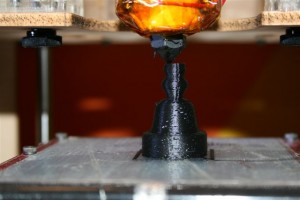
FDM 3D printers build layers of molten plastic to create parts. DLP 3D printers use light and resin.
THE EASY-BAKE OVEN OF 3D PRINTERS
DLP printers are like the easy bake oven of 3D printers. Only instead of using the heat generated from a light bulb to bake or cure the plastic resin, they use a special wavelength of light to activate the chemical reaction of the resin. What makes a 3D object printed with DLP different? Well, DLP objects are smoother, more detailed and more organic looking. In a FDM 3D printed object the individual layers are visible. Most DLP prints are almost seamless.
DLP printers have a vat full of resin which is suspended above a projector. The light from the projector shines up through the base of the vat at the resin. The projector only lights up the areas of the vat that are needed for the current layer/slice of the 3D model. A layer of specially coated glass is lowered into the vat and the freshly cured resin sticks to the glass. The glass is then raised up out of the liquid and then the projector fires again. The fresh resin sticks to the previous layer and begin to form a part. The process is repeated over and over again until the part is done.
3D SOFTWARE
3D models can be created using a variety of free Cad packages like AutoDesk 123D or Sketchup. You can also download free 3D models from http://thingaverse.com or use professional 3D software such as Solidworks, Geomagic Design or Autodesk Inventor. The hard work of creating slices of 3D models is handled by special software. This software automatically slices 3D models up into many slices and processes it for building in sequential order.
So when would you want to use DLP printing instead of Plastic printing? When you want to produce art objects or concept models that accurately reflex the finished product DLP has a slight advantage over extruded plastic. When you want to print a working part which will stand up to actual use, FDM printer have an advantage. Currently, FDM printers make the most durable part and are faster than DLP printers. One drawback with DLP is the parts are more fragile than printed ABS plastic. This is a situation that will probably change as new resins are developed specifically for DLP printing. New developments in resins are happening everyday. Less expensive resins are inevitable. Besides DLP prints blows FDM prints away.
DLP 3D PRINTERS GAINING SPEED
DLP printing is not new but it is affordable. DLP printing is similar to Stereo Lithography. Stereo Lithography is a technology that is closely related to DLP printing but uses lasers instead of light projectors. A recent Kickstarter.com campaign raised a million dollars in just a few days. The Form 1 Stereo Lithography product was so popular that the inventors decided to end the campaign early so that they would not be overwhelmed while trying to make the new product. The B9Creater DLP printer also had a great response on kickstarter and raised $513,000 during their campaign.
3D DLP printers are a convergence product that would have never developed with out the development of flat screen Televisions and projectors. DSP technology uses an array of microscopic mirrors which can be digitally manipulated to reflect light. The tiny mirrors can be rapidly rotated to reflect light, effectively turning the light on and off. With DLP 3D printing, a common DLP projector is used as the light source to cure the polymer resin. This convergence of technology is already having a broad impact in the field of manufacturing. To some, growing a 3D object from a vat of liquid resin seems like magic. Robert Heinlein stated that any significantly advanced technology will be indistinguishable from magic. Maybe Heinlein has a point here.
OTHER USES
DLP printers are not just used in manufacturing, they are also used to create fine art. Artist, educator and visionary Sophie Kahn is using 3D laser scanner to capture peoples likeness and then using that likeness to 3D print 3D sculptures. She then take the cured resin models and uses them to cast bronze final pieces. Her sculptures are surreal and very fluid. Check out her work at http://sophiekahn.net
WILL DLP DOMINATE 3D PRINTING?
The question on many peoples mind is which 3D printing technology will dominate. There is no easy answer to this question without considering the following. Will the need for a functional rapid prototypes of a product become essential to a businesses success? If the answer is yes (which I suspect it is.) then we will see a rapid proliferation of FDM 3D printers. However if the need is for a smooth finished replica of a proposed product, then DLP printing will dominate.
If either machining technology is able to combine both of these features, good looks and durable parts, it will become the dominant form. The winner will be the machine which can deliver the most professional looking, durable parts in the shortest amount of time.
In either case, everybody wins with 3D printing. Designers are free to have their work become reality, businesses can iterate through the design phase quickly and hobby builders can scratch their creative itch.
Sources:
http://www.thingiverse.com/thing:19185
http://www.3ders.org/articles/20130715-diy-high-resolution-3d-dlp-printer.html
http://www.ti.com/lit/ml/dlpb008/dlpb008.pdf
http://sedgwick3d.com
http://pinterest.com/imbillgriggs/3d-printers/
http://www.3ders.org/articles/20130715-diy-high-resolution-3d-dlp-printer.html
http://code.google.com/p/lemoncurry/wiki/main
http://setandbma.files.wordpress.com/2012/05/3d-limb.png
http://www.ti.com/solution/3d_printer
http://www.thingiverse.com/thing:29735
http://www.os-rc.com/en/
